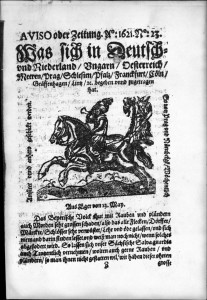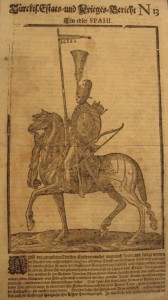by Jan Hillgaertner, University of St Andrews
 On 11 December, a group of around thirty doctoral students of book history met at the University of Stirling for the first History of Reading workshop, led by Katherine Halsey (Stirling) and Daniel Cook (Dundee). I got intrigued by the chance of partaking in a discussion on how to study the history of reading; especially of ephemeral material such as newspapers in the seventeenth century, a period that has received renewed attention.
On 11 December, a group of around thirty doctoral students of book history met at the University of Stirling for the first History of Reading workshop, led by Katherine Halsey (Stirling) and Daniel Cook (Dundee). I got intrigued by the chance of partaking in a discussion on how to study the history of reading; especially of ephemeral material such as newspapers in the seventeenth century, a period that has received renewed attention.
The day started off with a series of three papers. Dr Halsey reflected on general concepts of the history of reading and argued, that attempts to recuperate and understand reading choices, habits and practices of reading in the past constitute the field of research. Furthermore, that it has the potential to bring together literary scholars and historians. What followed was an inspection of possible sources for the study of reading history, ranging from library loans records over autobiographies, marginalia, letters, diaries, court records, and common place books. What forms a good piece of scholarship in the history of reading is a combination of all these evidences, she argued.
Anouk Lang, digital humanities specialist and lecturer on this topic at the University of Edinburgh, presented a paper on how to apply digital humanities tools to book historical research. The introduction of machine-aided analysis allows us to survey large datasets and answer questions that previously were not asked. Yet how do we find such sources that we can data-mine? Lang suggested starting one’s own research on already established projects such as scholarly online editions or Google Books. Finally, and for the more advanced students, she demonstrated how live data can be mined from Twitter and how we can for example study the reception of the recently deceased PD James in online channels.
Mark Towsey, lecturer in history at the University of Liverpool, was the second in line to give insight into his own current ongoing research of reading history. He focused on anecdotal evidence and the pressing question of how to fit such material – ideal for a case study – into a bigger research project and tackle the limitations that come with case-studies and micro-history. In his case, he studies the reaction of readers to a specific text for which not many such reactions can be found. This is often the starting position for the study of ephemeral texts beyond the literary genre; texts that were meant to be read only once such as newspaper articles. He argued that the reader’s reaction here may never be taken at face value but need to be placed within the wider cultural understanding of the text. If scholars think about the balances of probability of such evidence and elaborate in how far the reaction of one specific reader can be generalised, the evidence might serve to understand broader aspects of reading history.
In the final session, participants were grouped into smaller units to start discussing the applicability on individual research projects. This opened the forum for doctoral students to discuss their own take on reading history.
 My own research is concerned with the reception of news and newspaper printing in the seventeenth century. In this period, systematic studies of reading habits and patterns are made difficult by the poor survival of material. Furthermore, news is perishable and seldom became the object of lengthy reflections in diaries or journals. Studying the history of newspaper reading, we find ourselves confronted with one contradiction: the newspaper is seen as the medium that made a public sphere possible, yet little work has been done on the acts of newspaper reading in the Early Modern period. Most scholarship ends with mentioning coffeehouse culture and the practices of public debate of news reports and occurrences.
My own research is concerned with the reception of news and newspaper printing in the seventeenth century. In this period, systematic studies of reading habits and patterns are made difficult by the poor survival of material. Furthermore, news is perishable and seldom became the object of lengthy reflections in diaries or journals. Studying the history of newspaper reading, we find ourselves confronted with one contradiction: the newspaper is seen as the medium that made a public sphere possible, yet little work has been done on the acts of newspaper reading in the Early Modern period. Most scholarship ends with mentioning coffeehouse culture and the practices of public debate of news reports and occurrences.
Indeed, studying this subject is made difficult by the ephemeral nature of the source. Seldom are newspapers kept; and those who survive often stem from royal collections where newspapers were more often archived than read. For such readers, newspapers were only one source of news and often not the most important one.
The case of Benjamin Thompson, an American quidnunc who collected, annotated and archived newspapers throughout 1702–1712 has recently been studied by Uriel Heyd.[1] Thompson did not only read newspapers extensively but also annotated them and compiled glossaries on their content by subdividing the reports into various categories. However, this case is unique and newspaper reading has left almost no trace at all. In cases like this, suggests Dr Towsey, the application of an analysis of the balance of probability can be the key to understanding reading practices of newspaper. Even though in this particular instance ex negativo, as this was a highly untypical case of reading the newspaper.
For the German learned world of the seventeenth and eighteenth centuries, newspaper reading presented a practice that had to be guided in order to make it a fruitful experience. As early as 1665, university dissertations on this new practice were published and authors generally acknowledged the benefits of reading a periodical yet pointed to need for ‘publishing ethics’ that only allowed truthful reports to be published and required the reader to always be doubtful about the reporting. As interesting as these accounts are, their very nature as instructive, didactic and often even cautionary nature does not allow draw conclusions to contemporary reading practices. We must bear in mind that the authors of such texts often had limited experience with either the reading public as such or the daily routines of publishing a newspaper.
The workshop successfully shed a light on how actively reading research currently is undertaken. Lively discussions emerged from the scholarly input and networking amongst the doctoral students was greatly embraced.
[1] Uriel Heyd, Reading Newspapers: Press and Public in Eighteenth-Century Britain and America. Oxford: Voltaire Foundation, 2012.
Editor’s note: Jan’s blog can be found here.

Comments are closed.